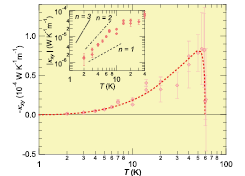Thermal Hall Effect of Phonons
Yamashita and Nakatsuji Groups
Hall measurements are fundamental probes for studying the physical properties of metals. Recently, Hall measurements in insulators, which are observed as thermal Hall effects (THEs), are being recognized as a new probe to study the elementary excitations in insulators. Since there is no charged heat carries in insulators, a THE in an insulator is not originated from the Lorentz force, but from intrinsic (e.g. Berry phase effect) or extrinsic (e.g. skew scatterings) mechanisms as the anomalous Hall effect. In fact, a THE of magnons has been observed in ferromagnetic insulators below the Curie temperature [1], which has been understood in terms of the Berry phase effect [2, 3]. A THE of paramagnetic spins has also been reported in the spin-liquid phase of a kagomé antiferromagnet [4].

Fig. 1. The temperature dependence of thermal Hall conductivity (κxy). The dashed line is a guide for the eyes. The inset shows |κxy| in log-log scale. The solid lines show slopes for |κxy|∝ Tn (n = 1, 2, 3).
In spite of these recent studies of spin THEs, a phononic THE has remained elusive. A phonon THE was actually reported at 2005 in Tb3Ga5O12 (TbGG) [5] prior to the observations of the spin THEs [1, 4]. However, the measurement of the phonon THE in TbGG was done only at ~5 K, disabling to find the temperature dependence of the thermal Hall conductivity (κxy). To find the theoretical model describing the phonon THE, it is indispensable to measure κxy in a wide temperature range and to compare the temperature dependence with the theoretical predictions. Furthermore, because TbGG is paramagnetic at ~5 K, it is impossible to exclude a spin THE.
To this end, we performed thermal Hall measurements in the spin-liquid candidate Ba3CuSb2O9 (BCSO) [6]. BCSO is a perovskite-type insulator, in which the spins of Cu2+ ions form a honeycomb structure. NMR measurements show that a spin gap opens below ~50 K, enabling us to detect a phono THE without a spin THE.
Our main result is to find a distinct thermal Hall signal in a wide temperature range of 2-60 K, revealing that the phonon THE in BCSO shows |κxy|∝ T2. As shown in Fig. 1, κxy is negative in the entire temperature range measured, shows a peak around 50 K, and decreases at lower temperatures. A log-log plot of |κxy| (inset of Fig. 1) shows that |κxy|∝ T2 at low temperature. We conclude that the THE comes from phonons because a spin THE is supposed to show an activated temperature dependence owing to the spin gap formed below 50 K.
What is the mechanism of the phonon THE in BCSO? In TbGG, phonon scatterings by excess Tb3+ ions have been pointed out as a possible mechanism of the phonon THE [8]. In BCSO, we also find the longitudinal thermal conductivity is strongly suppressed by a random structure of Cu2+-Sb5+ dumbbells. Therefore, this strong scattering effects on phonons in BCSO can be related to the phonon THE as that in TbGG. However, the T2 dependence of κxy has not been successfully reproduced by theories, which may be owing to the difference in scattering effects on phonons by the 4f Tb3+ ions with a large quadrupole moment and those by the 3d Cu2+ ions. We believe that our finding of |κxy|∝ T2 leads to further theoretical and experimental studies to clarify the mechanism of phonon THEs in insulators.
References
- [1] Y. Onose et al., Science 329, 297 (2010).
- [2] H. Katsura, N. Nagaosa, and P. A. Lee, Phys. Rev. Lett. 104, 066403 (2010).
- [3] R. Matsumoto, R. Shindou, and S. Murakami, Phys. Rev. B 89, 054420 (2014).
- [4] D. Watanabe et al., Proc. Natl. Acad. Sci. USA 113, 8653 (2016).
- [5] C. Strohm, G. L. J. A. Rikken, and P. Wyder, Phys. Rev. Lett. 95, 155901 (2005).
- [6] S. Nakatsuji et al., Science 336, 559 (2012).
- [7] K. Sugii, M. Shimozawa, D. Watanabe, Y. Suzuki, M. Halim, M. Kimata, Y. Matsumoto, S. Nakatsuji, and M. Yamashita, Phys. Rev. Lett. 118, 145902 (2017).
- [8] M. Mori et al., Phys. Rev. Lett. 113, 265901 (2014).
